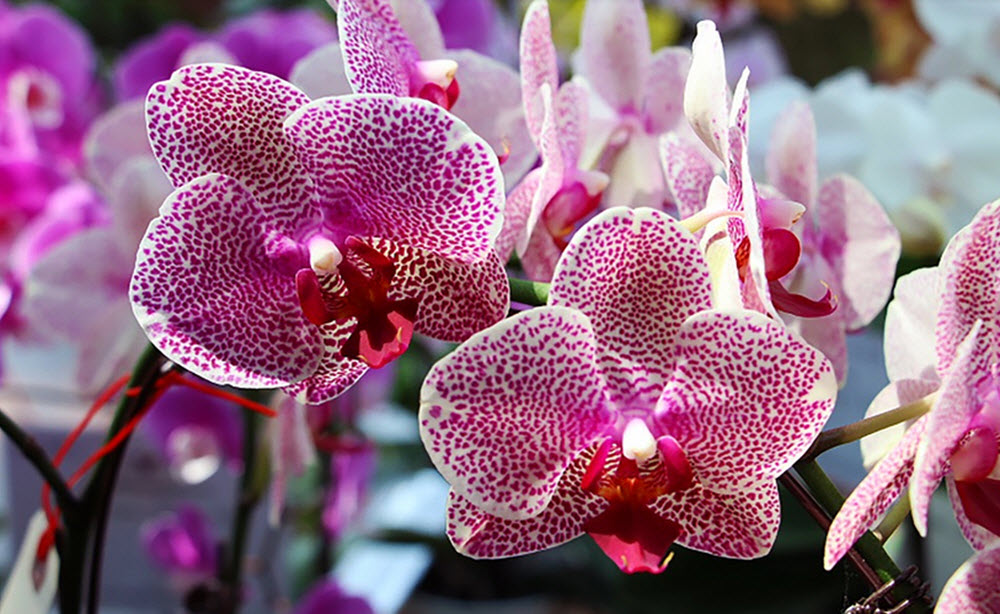Orchids belonging to the genus Vanda grows wild in parts of Asia and Oceania, including places such as the Indian subcontinent, the Himalayan region, southern China, the Philippines, and northern Australia.
A well-established and properly cared for Vanda orchid can bloom more than once a year, and each bloom can last for over eight weeks.

Did you know that the National Flower of Singapore is a Vanda orchid? More specifically, it is a hybrid Vanda orchid named Vanda Miss Joaquim var. Agnes, after the horticulturalist Agnes Joaquim who grew it in her garden in Tanjong Pagar. Vanda Miss Joaquim var. Agnes represents the spirit of Singapore by being colourful, tough and resilient.
In India, the Vanda orchid V. tessellata is utilized in traditional medicine and by shamans. The roots are used to treat conditions such as bronchitis, dyspepsia and hiccups, and juice from the leaves is applied topically against otitis. According to legend, shamans learned about the hypnotic narcosis properties of V. tessellata by seeing bees falling to the ground after feeding on nectar from these orchids.
Etymology
The name Vanda comes from Sanskrit.
Caring for Vanda orchids
Potting medium
Before selecting a potting medium, ideally find out if your Vanda orchid hails from epipythic, lithophytic or terrestrial orchid species. Most Vanda orchids are epipythic or lithopythic, which means that they grow on trees or stones, and can decay quickly if they are forced to stay in a soggy medium that does not drain quickly after waterings. Terresttrial orchid species that grow in the soil are more capable of handling a bit of prolonged moist without succumbing to rot. (But that doesn´t means its okay to drench them or plant them in heavy clay soil.)
If it is not possible to find out more specific potting medium recommendations for your Vanda, go with the middle road and use medium or coarse grade fir bark. Keep an eye on how the plant is doing and adjust if necessary.
Vanda orchids should only be repotted when necessary, not on a regular schedule ”just because”. So, when is it necessary? Here are a few examples:
– When the orchid has outgrown its pot.
– When the potting medium is not draining well enough.
– When the potting medium smells bad and/or is mouldy.
Watering
If the Vanda has fleshy leaves, it is adapted for an enviroment where it sometimes needs to rely on water stored in those leave. If the leaves are non-fleshy, the orchid is adapted to an environment where it doesn´t need to handle periods of water scarcity. Generally speaking, fleshy leaves are cylindrical on Vanda orchids, while flat leaves are ovoid.
A good rule of thumb for both types of Vanda orchid is to never water until the potting medium is completely dry. Vanda´s with fleshy leaves can typically handle going through a bit of drought / water scarcity, while Vanda´s with flat leaves should recieve plenty of water as soon as the medium is dry.
Nutrients
Give a 25-9-9 fertilizer year round.
Mix one teaspoon of fertilizer with plenty of water and spread out the servings over the course of a full month. Giving big helpings of fertilizer once or twice per month instead is not recommended.
Temperature
Recommended day temperature: 75 – 85˚ F (24 – 29˚ C)
Recommended night temperature: 65-75˚ F (18-24˚ C)
Light
Vanda orchids want a lot of sun in the mornings and late afternoon, but can be damaged if exposed to direct midday (11 am to 3 pm) sunlight.
If the leaves become very dark green, the plant needs more sun.